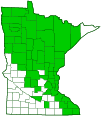scarlet Indian paintbrush
(Castilleja coccinea)
Conservation • Wetland • Description • Habitat • Ecology • Use • Distribution • Taxonomy
Description |
||
Scarlet Indian paintbrush is a 5″ to 24″ tall, erect, annual or biennial, hemiparasitic forb that rises on usually a single stem from a taproot rhizome caudex. In the first year it develops a rosette of basal leaves. In the second year it sends up flowering stems. The stems are ascending to erect, slender, usually unbranched, and covered with short, fine hairs. Basal leaves are inversely lance-shaped to egg-shaped, unlobed, up to 3¼″ long, and up to ¾″ wide. They are often present at flowering. Stem leaves are variable in form, linear to lance-shaped, 1¼″ to 3¼″ long, and up to ⅜″ wide. Some leaves are cleft with 3 to 5 linear lobes, the central lobe longer and broader than the lateral lobes. Some leaves are unlobed. The upper surface is hairy. The lower surface is hairy along the veins. The margins are untoothed. The inflorescence is a dense, red, 1½″ to 2⅜″ long spike at the end of the stem. When in fruit the spike is 4″ to 8″ long. Each flower is subtended by a large leaf-like bract. The bract is lance-shaped, usually deeply 3-lobed, occasionally 5-lobed. It is usually either green at the base and scarlet at the tip or almost entirely scarlet. Occasionally the bracts are yellow. The calyx is ⅝″ to 1″ long and divided into 2 rounded lobes. It is colored like the bracts. The corolla is inconspicuous, consisting of 5 petals fused for their entire length into a greenish-yellow tube that is 13 ⁄16″ to 1 1 ⁄16″ long, slightly longer than the calyx. They are usually at least partially concealed by the colorful bracts. The fruit is an asymmetrical, egg-shaped, ⅜″ long capsule containing numerous seeds. |
||
Height |
||
5″ to 24″ |
||
Flower Color |
||
Greenish-yellow with scarlet or yellow bracts |
||
Similar Species |
||
|
||
Habitat |
||
Wet to dry. Prairies, meadows. |
||
Ecology |
||
Flowering |
||
May to August |
||
Polymorphism |
||
Populations of scarlet Indian paintbrush in the upper Midwest show a high degree of bract polymorphism. The bract color in one population may be predominantly scarlet while in a nearby population the bract color is predominantly yellow. A recent study (Ki, et al., 2019) showed that where pollinators were abundant, the scarlet morph outproduced the yellow morph. Where pollinators were scarce, the yellow morph outproduced the scarlet morph. Plants with yellow bracts have been named Castilleja coccinea f. lutescens, while those with scarlet bracts have been named Castilleja coccinea f. coccinea. |
||
Parasitism |
||
Plants in the genus Castilleja are hemiparasitic. They obtain water and mineral nutrients from the roots of grasses and forbs, but are also photosynthetic, producing chlorophyll. Though it can survive on its own, it has a forty-fold increase in growth when it parasitizes the roots of other plants. |
||
Pests and Diseases |
||
|
||
Use |
||
|
||
Distribution |
||||
|
Sources |
|||
| 6/8/2023 | ||||
Nativity |
||||
Native |
||||
Occurrence |
||||
|
||||
Taxonomy |
|||
| Kingdom | Plantae (Plants) | ||
| Subkingdom | Pteridobiotina | ||
| Phylum | Tracheophyta (Vascular Plants) | ||
| Class | Magnoliopsida (Dicots) | ||
Order |
Lamiales (Mints, Plantains, Olives, and Allies) | ||
Family |
Orobanchaceae (broomrape) | ||
| Tribe | Pedicularideae | ||
| Genus | Castilleja (paintbrushes) | ||
Subordinate Taxa |
|||
|
|||
Synonyms |
|||
Castilleja ludoviciana |
|||
Common Names |
|||
Indian paintbrush painted cup painted-cup painted-cup paintbrush scarlet Indian paintbrush scarlet Indian-paintbrush scarlet paintbrush scarlet painted-cup |
|||
Visitor Photos |
|||||
Share your photo of this plant. |
|||||
| This button not working for you? Simply email us at info@MinnesotaSeasons.com. Attach one or more photos and, if you like, a caption. |
|||||
|
|||||
MinnesotaSeasons.com Photos |
|||||
Habitat |
|||||
_02s.jpg) |
|||||
Plant |
|||||
_03s.jpg) |
_04s.jpg) |
||||
Inflorescence |
|||||
_01s.jpg) |
_05s.jpg) |
||||
Yellow morph plant |
|||||
_03s.jpg) |
_02s.jpg) |
||||
Yellow morph inflorescence |
|||||
_01s.jpg) |
|||||

Visitor Videos |
|||
Share your video of this plant. |
|||
| This button not working for you? Simply email us at info@MinnesotaSeasons.com. Attach a video, a YouTube link, or a cloud storage link. |
|||
Other Videos |
|||
| Indian Paintbrush (Castilleja coccinea) PrairieMoonNursery |
|||
About
Uploaded on May 24, 2010 http://www.prairiemoon.com May 17. Indian Paintbrush provides that rare red color in a prairie but can be difficult from seed - it needs a host plant. We have had success w/ drier prairie grasses: Little Blustem, Side-oats Grama, Hairy Grama, Blue Grama, June Grass or a drier Sedge (Carex). |
|||
| The Castilleja Code College First Science First |
|||
About
Published on Aug 31, 2012 A College First 2012 research project presentation at the Chicago Botanic Garden by Danya Springer, Urban Prep Academy. Mentors: Anna Braum, Plant Science and Conservation; Evan Eiffler, REU Intern Video services by John Sanner |
|||

Visitor Sightings |
|||||
Report a sighting of this plant. |
|||||
| This button not working for you? Simply email us at info@MinnesotaSeasons.com. Be sure to include a location. |
|||||
| Sandra Shirek 6/12/2020 |
Location: Chippewa National Forest (Woodtick Trail) |
||||
MinnesotaSeasons.com Sightings |
|||||

|
Created: Last Updated: © MinnesotaSeasons.com. All rights reserved. |


